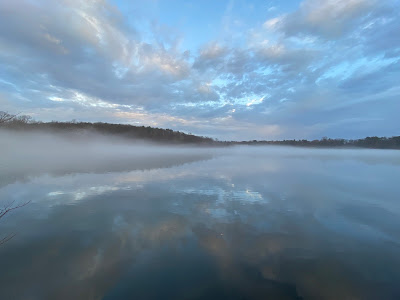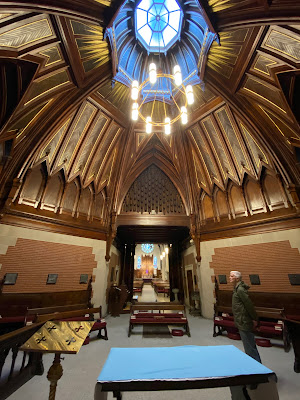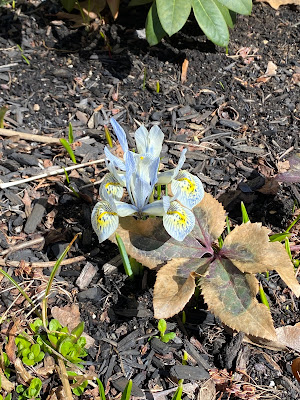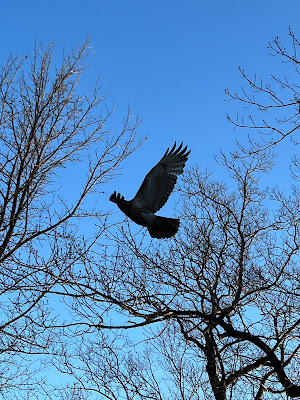April 2022
April 1 Mist over the pond this morning.
Went to visit my friends Sam and Annie in Portland, Maine for a couple of days. Sam was keen to show me the round chapel at his church, St. Luke's Cathedral. Once there, I could see why: it's amazing - beautifully polished mahogany and gold leaf ceiling with a skylight (I suspect it has some church-y name).
April 2 Saturday morning, we went for a walk in the woods, along the Mill Brook in Westbrook, just outside of Portland. A little later in the spring, alewife run up the stream from Casco Bay; Sam says the stream is thick with them at the peak of the run in late May/early June.
And here's what Wikipedia has to say about alewife:
"The alewife (Alosa pseudoharengus) is an anadromous species of herring found in North America. As an adult it is a marine species found in the northern West Atlantic Ocean, moving into estuaries before swimming upstream to breed in freshwater habitats, but some populations live entirely in fresh water. It is best known for its invasion of the Great Lakes by using the Welland Canal to bypass Niagara Falls. Here, its population surged, peaking between the 1950s and 1980s to the detriment of many native species of fish. In an effort to control them biologically, Pacific salmon were introduced, only partially successfully. As a marine fish, the alewife is a US National Marine Fisheries Service "Species of Concern"."
Impressive that they found their way up the Welland Canal and got into Lake Erie. When I used to visit my parents in Burlington, Ontario, at the western tip of Lake Ontario, we would go for walks near their house, in an area of the Royal Botanical Gardens with a stream running through a marsh. During the salmon run, there would be good-sized salmon thrashing their way up the stream, their bodies littering the banks; Sandy, the yellow Labrador I had at the time, was completely fascinated by this.
Back at Sam and Annie's house, a dwarf iris blooming in the garden.
And a bespectacled fox reading under their Little Free Library.
April 4 Driving along the Arborway, stopping at a red light, I see a squirrel poking its head out of the tree cavity where the screech owls had been hanging out; I think they must have moved on and won't be back. Later, at the ball field, the red-tailed hawk is on the nest. A single male common merganser remains at Jamaica Pond. Also a handful of ruddy ducks, one with chestnut red breeding plumage; I tried to look to see if it's bill had turned robin's egg blue, but it was tucked under its wing, dozing.
April 5 Walk in the Arb, flowers coming out more and more. I particularly love the carpets of blue scilla.
In the afternoon, puttering around the kitchen, I see a cedar waxwing at the water basin in my back garden, filtting off and returning several times. Spectacular. Cedar waxwings specialize in eating fruit (but also eat insects when available); Cornell's All About Birds says their name comes from their "appetite for cedar berries in winter" as well as the bright red waxy secretions at the tips of their secondary wing feathers. All About Birds also says that they "occasionally become intoxicated or even die when they run across overripe berries that have started to ferment and produce alcohol." Yikes. There's a wonderful photo of one in flight, feathers all splayed out, showing the red tips of the secondary wing feathers as well as the yellow tips of the tail feathers, if you click through the photos at the above link (go to "ID Info", then "Photo Gallery").
April 8 In the rain this morning, saw a squirrel perched in the tree cavity at the end of the street, head poking out, tail wrapped around its body and over its head. At the pond, a single pair of common mergansers remaining along with a few ruddy ducks. At the ball field, one of the hawks, standing on the nest, took off, and a few seconds later the other one landed on the nest and settled down, just its head appearing over the sticks. Heard the red-bellied woodpeckers calling in the woods.
Went to Drumlin Farm, one of Mass Audubon's sanctuaries in Lincoln, to look for baby animals. Lots of lambs about in a field, three black ones jumping up onto a rock and then looking very nervous and tentative about how to get down again. One white lamb on wobbly little legs, maybe just a few days old.
Goat kids, snuggled up with Mom in the barn.Then later, head butting each other on a table next to the barn.
Back home, blossoming trees along the neighbourhood streets.
April 9 Mergansers gone from Jamaica Pond. A handful of ruddy ducks left. Only one pair of ring-necked ducks left at Ward's Pond, down from the half dozen there most of the winter.
As I approached the ball field, one of the red-tail hawks took off from the nest, flew across the field and landed high up in one of the nearby trees. Saw the other one settling down on the nest immediately. All About Birds says that they typically have 1-5 eggs, "white or buffy, blotched or speckled with buff, brown, or purple", that are incubated for 28-35 days. The hatchlings then take 42-46 days to fledge. I'll be watching for them. And here's another tidbit from the website - "The oldest known wild Red-tailed Hawk was at least 30 years, 8 months
old when it was found in Michigan in 2011, the same state where it had
been banded in 1981." I had no idea they could live so long.
Red-bellied woodpecker pecking at a broken off branch on a tree near the parking lot by Ward's Pond.
April 10 Swan boats getting ready to migrate to the Public Garden later this week. The swan boat business was started in 1877 by Robert Paget; the current owners, the fourth generation of Pagets to run the business, live in my neighbourhood. The boats are catamarans with a foot-propelled paddle wheel; the swans were designed to cover up the mechanical workings of the wheel. According to the swan boat website:
"The idea came to him from his familiarity with the opera Lohengrin. The opera is based on a medieval German story in which Lohengrin, a knight of the Grail crosses a river in a boat drawn by a swan to defend the innocence of his heroine, Princess Elsa."
A couple of days later, a large flatbed truck pulled up to the house to move the bases.
April 11 With the warmer weather, I've started riding my bike again. Saw this group of tiny stone birds at the base of a tree along the Muddy River, right by the Longwood T station.
April 13 Cherry blossom in the back yard of the rabbit guys' house. Chris says when they planted them, they thought they were going to be about 9' high; they're nearly as tall as the house now.
April 15 Spotted a pair of wood ducks paddling near the boat house. When I walked behind the boat house to get a better look at them, Maddie stuck her nose into a pile of leaves in the corner and suddenly we were set upon by an angry Canada goose, furiously flapping its wings at my head: we had disturbed his mate sitting on the nest. She stood up just long enough for me to glimpse her cream colored eggs before we retreated. I had no idea there was a nest there beforehand. I went back later on with the spotting scope to get this photo.
Here's what All About Birds from Cornell has to say about nesting Canada geese:
"On the ground, usually on a muskrat mound or other slightly elevated site, near water. They prefer a spot from which they can have a fairly unobstructed view in many directions. Female selects the site and does much of nest construction. She adds down feathers and some body feathers beginning after the second egg is laid. She does all the incubation while her mate guards her and the nest."
Their nest fits the description perfectly: about 3 feet above water level, with a great view of the pond.
Once I had the scope with me, I took a photo of a lone male ruddy duck who was diving over and over. His feathers are turning to the ruddy red for which the ducks are named and his bill was turning robin's egg blue for the breeding season.
After I got home, I walked to the center of Jamaica Plain to drop off some sweaters for dry cleaning. Going down Eliot Street I saw a tiny bird with a red patch on its crown: a male ruby-crowned kinglet. It was darting around the lower branches of some trees and then flew into a holly bush where it continued to flit around, accompanied by a female, just a few feet from me. They continued to zip around the trees along the driveway, circling around each other, up and down and around, much frenzied action. I don't see them very often, so it was delightful to watch them for a few minutes.
April 16 On our way out this morning, lots of blue jay screaming. Looking up, 2 jays mobbing a hawk perched on a branch, flying at it, swerving at the last second. It worked: the hawk took off.
April 18 Ruddy ducks still at Jamaica Pond. The ring-necked ducks all gone from Ward's Pond. The hawk is sitting on the nest at the ball field along the Jamaicaway; I keep an eye on it hoping to see the hatchlings. At Leverett Pond, 3 male wood ducks, one parked on one of the islands, the other two sitting on a downed log next to the island. Saw a couple of red-bellied woodpeckers and a downy, all pecking in the same wooded area near the pond.
In the evening, I get a text from my neighbor, Mary, saying she just saw an eagle dive and catch a fish at Jamaica Pond! So great! I head out to the pond, looking for the eagle. I miss it, but do see a hawk, I think a red-tail, swoop by, with a squirrel dangling from its talons, and land in on a tree branch, draping the squirrel's tail over the branch.
April 20 Saw a hawk fly over the pond and land in some trees near the tiny beach and then a minute later, a second hawk follow it. I went over to where they had gone into the trees and found them both perched in nearby trees, being mobbed by blue jays.
Another photo one of the other walkers, Lydia, sent me.
April 21 The male ruddy duck is still at Jamaica Pond, looking ruddier and ruddier, and bill bluer and bluer, by the day. It's wonderful to see him, but I'm surprised he's still here as they usually migrate away before changing into their breeding plumage. Their breeding grounds are much further west, past the Mississippi and into the Rockies.
Went to Mass Audubon's Broadmoor sanctuary to walk with my friend, Lori, this morning. Beautiful day: sunshine, mild, spring bursting all over. The meadow by the parking lot was all aflutter with tree swallows, zipping up, down and around, occasionally perching on the bluebird nesting boxes there. On our walk past the marsh I kept hearing a red-bellied woodpecker calling, but couldn't find it in the trees. On the water, lots and lots of turtles, from teeny-weeny sized to dinner-plate sized, sunning themselves on clumps of dirt poking above the water and on downed trees, soaking in the day's warmth. Walked through the woods to a pond where there was a pair of wood ducks paddling about. More tree swallows over the grassy bank of the pond. Walked along the Charles River loop, enjoying views of the river. At one point we saw a warbler, but couldn't tell what species. On the way back, almost at the marsh and boardwalk, heard more red-bellied woodpeckers and then a pileated woodpecker, the largest woodpecker in North America, flew through the trees and landed on a trunk. We got good views of it - wonderful! I haven't seen a pileated in maybe 5 years, so very exciting; Boston is at the very eastern edge of their range. Love their red caps! And finally, on the way back past the marsh, Lori finally found the red-bellied woodpecker on a dead tree trunk.
April 23 Sunrise over the pond.
April 26 Walking Maddie at the pond this morning, I noticed this wonderful quote, in moss, from Frederick Law Olmsted, that appeared on the bandstand next to the boathouse since yesterday. "...gradually, and silently, the charm comes over us; we know not exactly where or how." Today is his 200th birthday and the Emerald Necklace Conservancy is celebrating!
The male ruddy duck in breeding plumage is gone.
April 29 On our evening walk at dusk, we spotted yet another rabbit, nibbling on a neighbour's lawn. When it hopped away, there was a rather surprised looking little baby rabbit, just 3 or 4 inches long, right beneath where the adult had been. The little one froze for a moment and then hopped off into the daylilies. When I looked where it had gone, I found a little rabbit den opening. Notice the little hole in the ground at the bottom of the photo, below the dried out grasses.
April 30 The red-tailed hawk is still on the nest at the ball field; this morning I could see it tearing at something (squirrel? rabbit?) in the nest. All About Birds says that red-tails
incubate eggs for between 28 and 35 days. I first spotted a hawk sitting on the nest on March 14, nearly 7 weeks ago, which makes me wonder if the eggs have hatched and there are hatchlings already in the nest, although I couldn't see any. Perhaps the adult was tearing at whatever to feed the hatchlings. Once hatched, the young take about 6 weeks to fledge. I'll be keeping an eye on the nest, looking for them.
As I was watching with the telescope, several people asked what I was looking at. One burly guy, wearing a jacket from a demolition company, walking an immaculately clean white Scottie terrier, told me about seeing peregrine falcon hatchlings on the Customs Tower downtown when his company was doing some demolition work on the building. Very cool.
Also this morning, downy woodpecker, goldfinch and a warbler that I couldn't identify.
Cattails at Ward's Pond getting taller; it's amazing how quickly they grow at this time of year.



























Comments
Post a Comment